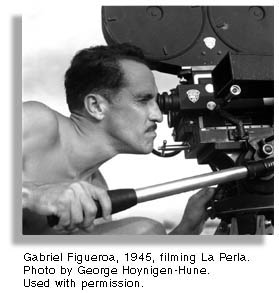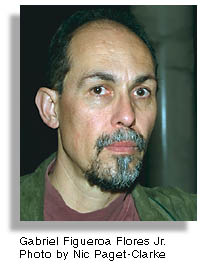| Gabriel Figueroa is considered the fourth of the three top Mexican muralists
Gabriel Figueroa Flores Jr.
"It happened that Orozco sat right next to my father." Interview by Fred Salas San Diego, California
Fred Salas: I find it interesting that they call your father Gabriel Figueroa the fourth of the three top Mexican muralists, the legendary Mexican muralists. What are your feelings about that? Why do they do that? Gabriel Figueroa Flores Jr.: At that time, he was very good friends with Diego Rivera, (David Alfaro) Siqueiros and (Jose Clemente) Orozco, the three of them. Rivera used to say that my father, his pictures were murals in movement. Not only that, they could travel all over the place which made them more accessible to people than his own works. With Siqueiros, it was another relationship. Whenever my father was invited to one of his exhibits, he would come in and Siqueiros would tell him, "Now you come and see what I stole from you." And my father would say "Oh no. I come to see what I can steal from you." Composition-wise and theme-wise. And the third, who also had a very good attitude, was Orozco. The only time that my father recognized openly that he took a composition out of a painting, from a muralist, it was Orozco's. It was a water color that Orozco made of a funeral of Velorio. This water color is called The Requiem. And my father, in a picture called Flor Sylvestre with Dolores del Río, took this very same composition and interpreted it. So it happened that the day that the film was screened for the first time, Dolores del Río invited all her friends, and among her friends was Orozco. It happened that Orozco sat right next to my father. And when the scene came on, Orozco jumped out of his seat. My father said "Maestro, I am an honest thief. I took that from one of your water colors". Orozco said "Of course, the depth and the volume you have in this composition is something that I didn't get in my water color. You must show me how you work so that I can see the magic of this scene." Fred Salas: That's amazing. How many films did your father make with Dolores del Río? Gabriel Figueroa Flores Jr.: I didn't count them, but there must have been about fifteen or twenty. Fred Salas: They were very much a team, a Mexican cinematic team. Gabriel Figueroa Flores Jr.: Yes. Dolores del Río, when she came back from Hollywood, teamed up to make Mexican movies and Mexican themes. She was very good at that because she was friends of Rivera and of Mauricio Magdaleno who wrote most of the scripts with Indio Fernandez, with my father. They teamed up and made all these films with Mexican themes. Fred Salas: What are your thoughts about the resurgence of the popularity of your father, and these films? I think this is the second or the third festival that he's been paid homage to. Gabriel Figueroa Flores Jr.: I think my father's career was stardom from the very beginning. It's difficult to call it a resurgence. I think new generations are getting acquainted with his work. That is really amazing because in this day and age, when the media have so much information to show, so many programs on TV, so many movies in theaters, so many festivals around the world, it's really amazing that they still want to see these classical films. That is what amazes me. Not the fact that my father was successful since the very beginning. Fred Salas: Tonight it was a full-house to see this beautiful work (María Candelaria) and I know with the younger film makers, there's a young Chicano film maker named Carlos Avila, he admitted to me that he stole, borrowed honestly, from your father, from Macario. I think it goes round and round. Your father felt like he had stolen from these muralists, the young filmmakers today are borrowing honestly from your father. Gabriel Figueroa Flores Jr.: I think Hombrage, the art critic and theoretician, said art is made from other arts and for artists. I believe that is a way artists nurture from other forms of art. (1) from "Forging a National and Popular Art cinema in Mexico: Maria Candelaria" by Sergio de la Mora. Fred Salas is co-director of the San Diego / Baja California Latino Film Festival and director and founder of Este Lugar / The Border Film Festival in Mesilla, New Mexico.
Published in In Motion Magazine May 20, 1998 |
If you have any thoughts on this or would like to contribute to an ongoing discussion in the  What is New? || Affirmative Action || Art Changes || Autonomy: Chiapas - California || Community Images || Education Rights || E-mail, Opinions and Discussion || En español || Essays from Ireland || Global Eyes || Healthcare || Human Rights/Civil Rights || Piri Thomas || Photo of the Week || QA: Interviews || Region || Rural America || Search || Donate || To be notified of new articles || Survey || In Motion Magazine's Store || In Motion Magazine Staff || In Unity Book of Photos || Links Around The World NPC Productions Copyright © 1995-2020 NPC Productions as a compilation. All Rights Reserved. |


 Gabriel Figueroa Flores Jr. is a photographer and the son of Gabriel Figueroa, the cinematographer of over 200 films. Gabriel Figueroa is credited with "creating the classic Mexican film aesthetic."
Gabriel Figueroa Flores Jr. is a photographer and the son of Gabriel Figueroa, the cinematographer of over 200 films. Gabriel Figueroa is credited with "creating the classic Mexican film aesthetic." 